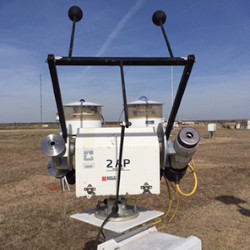Radiation Data Quality VAP Data Reprocessed for SGP Broadband Radiometer Station
Published: 19 July 2021

An end-to-end reprocessing of data from the Data Quality Assessment for ARM Radiation Data value-added product (QCRAD VAP) is complete for the broadband radiometer station (BRS) at the Southern Great Plains (SGP) atmospheric observatory. All historical data (from September 1, 1993, to August 6, 2019) are reprocessed and now available.
QCRAD has long been the Atmospheric Radiation Measurement (ARM) user facility’s recommended datastream for broadband surface irradiance measurements. QCRAD applies multiple data quality checks, corrects for errors due to infrared loss in shortwave radiometric measurements, and calculates a best-estimate total downwelling shortwave irradiance value.
The reprocessing used corrected qcrad1long code, fixing a temperature units bug that caused incorrect Dutton coefficients to be created. The Dutton coefficients are used in infrared loss correction for the unshaded pyranometer, which is the source of the global downwelling shortwave hemispheric irradiance variable (down_short_hemisp) in the QCRAD VAP output. The data for this variable were shifted downward by about 10–15 W/m2 at the peak of the signal. (Please note that down_short_hemisp is sometimes used in the best estimate of total downwelling shortwave data.)
Previously, the yearly QCRAD BRS processing produced *.c2 and *.s2—or level 2—datastreams (the asterisk represents the datastream name). Production of the summary .s2 datastream has been discontinued, and sgpqcradbrs1longC1.s2 data have been removed from the ARM Data Center to avoid mismatches with new .c2 files. All information found in the old .s2 files exists in the qcrad1long.c2 files.
Scientists can use the new QCRAD BRS data now. Access the data in the ARM Data Center. (Go here to request an account to download the data.)
More information on QCRAD is available on the VAP web page. To share your experience—such as how you use the data and how well they work for you—or to ask a question, contact ARM translator Damao Zhang or developer Josh Howie.
To cite the QCRAD BRS data, please use doi:10.5439/1227217.
Keep up with the Atmospheric Observer
Updates on ARM news, events, and opportunities delivered to your inbox
ARM User Profile
ARM welcomes users from all institutions and nations. A free ARM user account is needed to access ARM data.


















